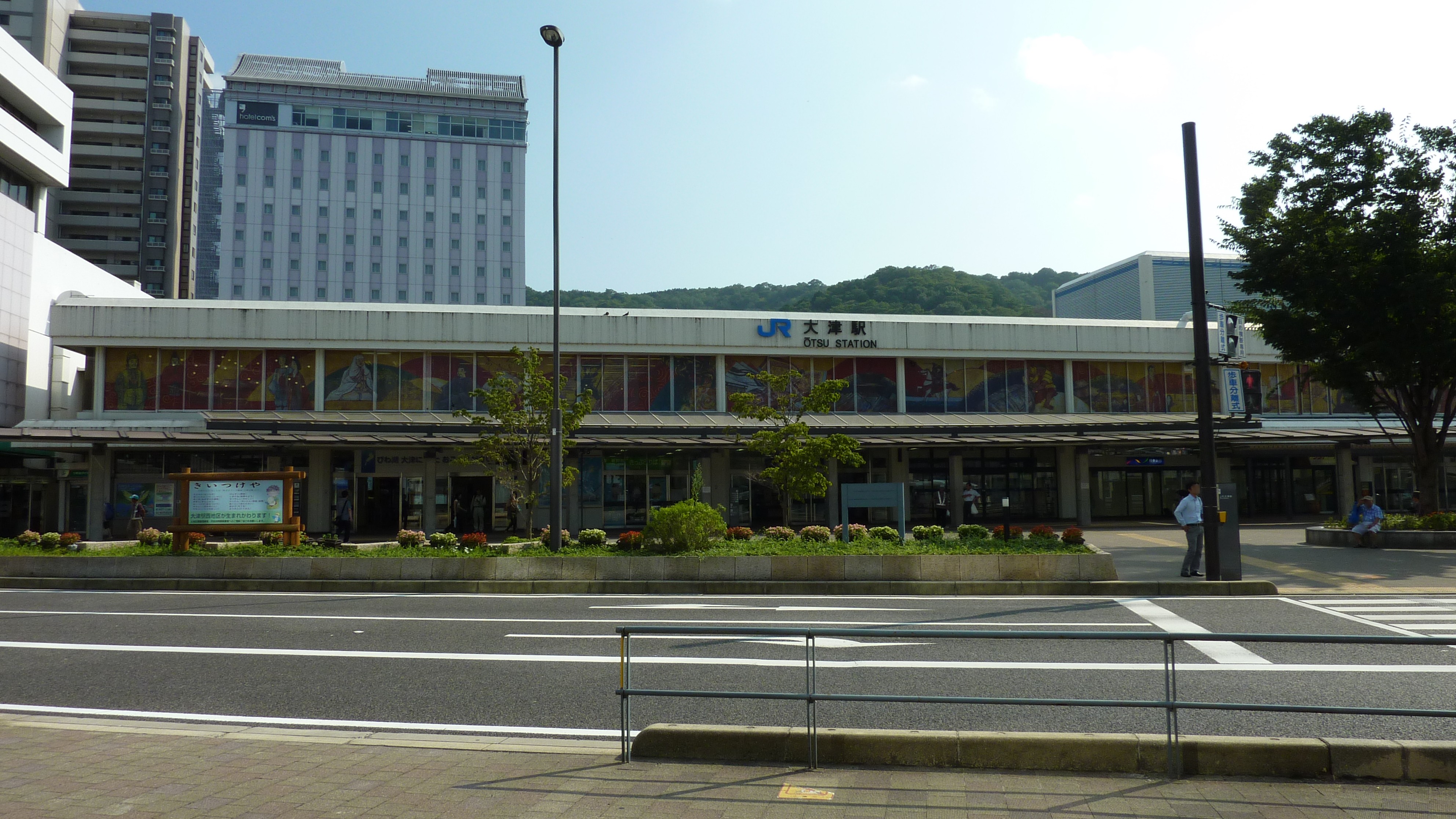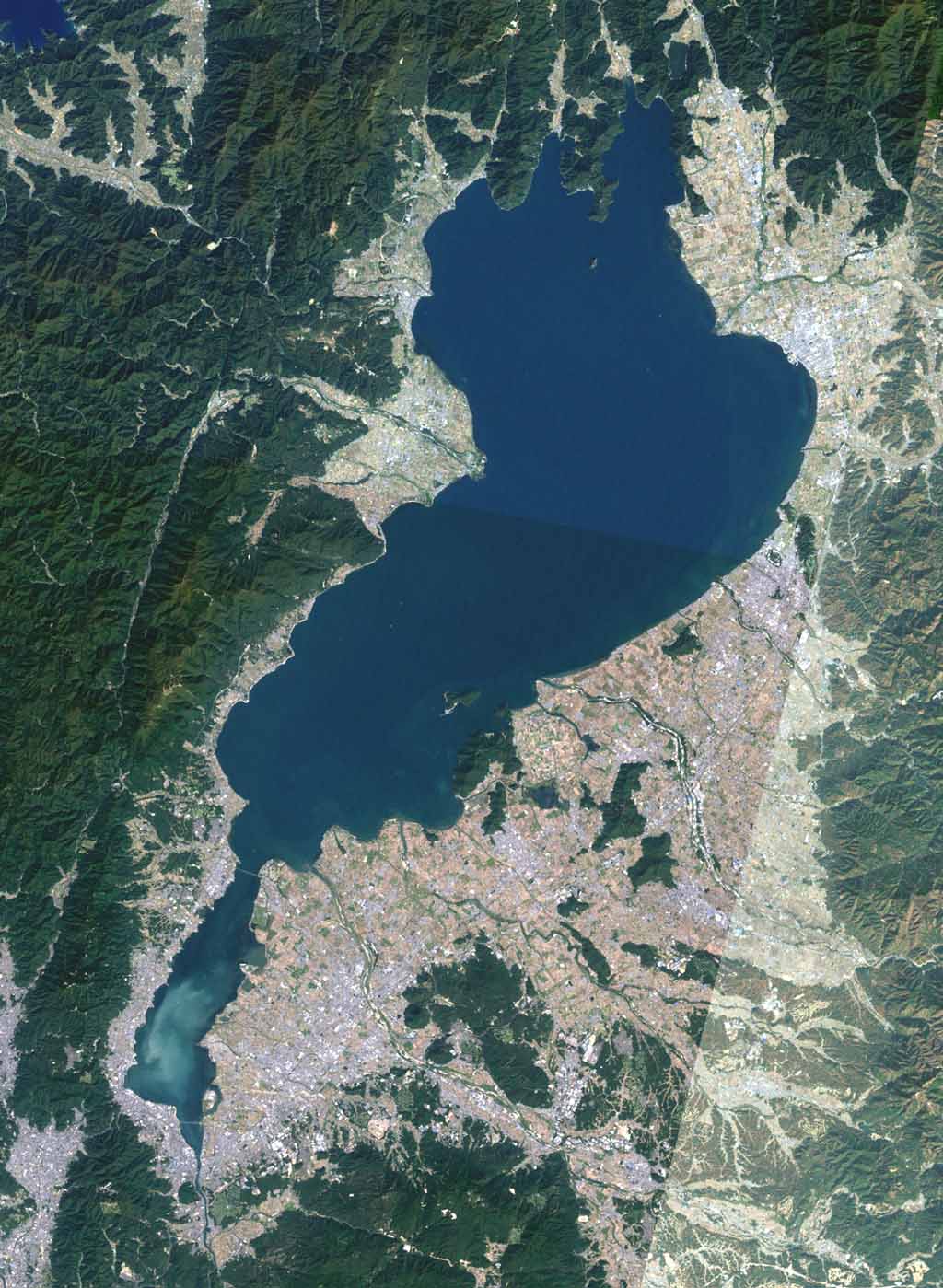|
Cable Sakamoto Station
is a funicular railway station located in the city of Ōtsu, Shiga Prefecture, Japan, operated by the private railway company Hieizan Railway. Lines Cable Sakamoto Station is the lower terminus of the Sakamoto Cable, and is 2.0 kilometers from the upper terminus of the line at . It is the longest cable-car route in Japan at 2,025 meters. Station layout The station consists of a single bay platform, and when it is crowded, the doors on both sides of the train may be opened to drop passengers. The track has a slope of 160 ‰, but the platform is not a slope but a gentle staircase. The station building was built in 1925 and is a two-story Western-style structure with a ticket office, a waiting room, and a crew waiting room on the first floor and offices on the second floor. The station building received protection by the national government as a Tangible Cultural Property (Japan), Registered Tangible Cultural Property in 2017. Adjacent stations History Cable Sakamoto Sta ... [...More Info...] [...Related Items...] OR: [Wikipedia] [Google] [Baidu] |
Hieizan Railway
The , officially the , is a Japanese funicular line in Ōtsu, Shiga. It is the only line operates. The line opened in 1927, as an eastern route to Enryaku-ji, a famous temple on Mount Hiei. This is the longest funicular line in Japan. Basic data *Distance: *Rail gauge, Gauge: *Stations: 4 *Vertical interval: Stations See also *Keifuku Cable Line – on the other side of the mountain *List of funicular railways *List of railway companies in Japan *List of railway lines in Japan External links Official website Funicular railways in Japan Rail transport in Shiga Prefecture 1067 mm gauge railways in Japan Japanese companies established in 1927 Railway companies established in 1927 {{Japan-cable-line-stub ... [...More Info...] [...Related Items...] OR: [Wikipedia] [Google] [Baidu] |
Sakamoto Cable
The , officially the , is a Japanese funicular line in Ōtsu, Shiga. It is the only line operates. The line opened in 1927, as an eastern route to Enryaku-ji, a famous temple on Mount Hiei. This is the longest funicular line in Japan. Basic data *Distance: *Gauge: *Stations: 4 *Vertical interval: Stations See also * Keifuku Cable Line – on the other side of the mountain *List of funicular railways *List of railway companies in Japan *List of railway lines in Japan List of railway lines in Japan lists existing Rail transport, railway lines in Japan alphabetically. The vast majority of Japanese railways are classified under two Japanese laws, one for and another for . The difference between the two is a leg ... External links Official website Funicular railways in Japan Rail transport in Shiga Prefecture 1067 mm gauge railways in Japan Japanese companies established in 1927 Railway companies established in 1927 {{Japan-cable-line-stub ... [...More Info...] [...Related Items...] OR: [Wikipedia] [Google] [Baidu] |
Funicular
A funicular ( ) is a type of cable railway system that connects points along a railway track laid on a steep grade (slope), slope. The system is characterized by two counterbalanced carriages (also called cars or trains) permanently attached to opposite ends of a haulage cable, which is looped over a pulley at the upper end of the track. The result of such a configuration is that the two carriages move synchronously: as one ascends, the other descends at an equal speed. This feature distinguishes funiculars from inclined elevators, which have a single car that is hauled uphill. The term ''funicular'' derives from the Latin word , the diminutive of , meaning 'rope'. Operation In a funicular, both cars are permanently connected to the opposite ends of the same cable, known as a ''haul rope''; this haul rope runs through a system of pulleys at the upper end of the line. If the railway track is not perfectly straight, the cable is guided along the track using sheaves – unpowered ... [...More Info...] [...Related Items...] OR: [Wikipedia] [Google] [Baidu] |
Railway Station
Rail transport (also known as train transport) is a means of transport using wheeled vehicles running in railway track, tracks, which usually consist of two parallel steel railway track, rails. Rail transport is one of the two primary means of land transport, next to road transport. It is used for about 8% of passenger and rail freight transport, freight transport globally, thanks to its Energy efficiency in transport, energy efficiency and potentially high-speed rail, high speed.Rolling stock on rails generally encounters lower friction, frictional resistance than rubber-tyred road vehicles, allowing rail cars to be coupled into longer trains. Power is usually provided by Diesel locomotive, diesel or Electric locomotive, electric locomotives. While railway transport is capital intensity, capital-intensive and less flexible than road transport, it can carry heavy loads of passengers and cargo with greater energy efficiency and safety. Precursors of railways driven by human or an ... [...More Info...] [...Related Items...] OR: [Wikipedia] [Google] [Baidu] |
Ōtsu
270px, Ōtsu City Hall is the capital city of Shiga Prefecture, Japan. , the city had an estimated population of 343,991 in 153,458 households and a population density of 740 persons per km2. The total area of the city is . History Ōtsu is part of ancient Ōmi Province and has been settled since at least the Yayoi period. It was an important center of inland water transportation on Lake Biwa and was referred to in the Man'yōshū as and . It was also on the main land routes, the Tōkaidō and the Nakasendō connecting the eastern provinces with the ancient capitals of Japan. Additionally, the ancient Hokurikudō, which connected Kyoto to the provinces of northern Honshu, ran through Ōtsu. From 667 to 672, the Ōmi Ōtsu Palace was founded by Emperor Tenji was the capital of Japan. Following the Jinshin War Ōtsu was renamed . A new capital, Heian-kyō, (now Kyoto), was established in the immediate neighborhood in 794, and Ōtsu (meaning "big port") was revived as ... [...More Info...] [...Related Items...] OR: [Wikipedia] [Google] [Baidu] |
Shiga Prefecture
is a landlocked prefecture of Japan in the Kansai region of Honshu. Shiga Prefecture has a population of 1,398,972 as of 1 February 2025 and has a geographic area of . Shiga Prefecture borders Fukui Prefecture to the north, Gifu Prefecture to the northeast, Mie Prefecture to the southeast, and Kyoto Prefecture to the west. Ōtsu is the capital and largest city of Shiga Prefecture, with other major cities including Kusatsu, Nagahama, and Higashiōmi. Shiga Prefecture encircles Lake Biwa, the largest freshwater lake in Japan, and 37% of the total land area is designated as Natural Parks, the highest of any prefecture. Shiga Prefecture's southern half is located adjacent to the former capital city of Kyoto and forms part of Greater Kyoto, the fourth-largest metropolitan area in Japan. Shiga Prefecture is home to Ōmi beef, the Eight Views of Ōmi, and Hikone Castle, one of four national treasure castles in Japan. History Shiga was known as Ōmi Province or Gōshū bef ... [...More Info...] [...Related Items...] OR: [Wikipedia] [Google] [Baidu] |
Bay Platform
In the United Kingdom and in Australia, a bay platform is a dead-end railway platform at a railway station that has through lines. It is normal for bay platforms to be shorter than their associated through platforms. They must have a buffer stop at one end for safety. Overview Bay and island platforms are so named because they resemble the eponymous geographic features. Examples of stations with bay platforms include Carlisle railway station, Ryde Pier Head railway station, Nottingham railway station (pictured), which has a bay platform inset into one of its platform islands; and the San Francisco International Airport (BART station), San Francisco International Airport BART Station which has three bay platforms, two of which are in use. Chicago's CTA O'Hare (CTA), O'Hare Airport Station features a bay platform with one track on the bay and a track on each side of the platform. Millennium Station in Chicago has several bay platforms for the South Shore Line and Metra. The H ... [...More Info...] [...Related Items...] OR: [Wikipedia] [Google] [Baidu] |
Tangible Cultural Property (Japan)
A as defined by the Japanese government's Law for the Protection of Cultural Properties is a part of the Cultural PropertiesIn this article, capitals indicate an official designation as opposed to a simple definition, e.g "Cultural Properties" as opposed to "cultural properties". of high historical or artistic value such as structures, paintings, sculptures, handicrafts, calligraphic works, ancient books, historic documents, archeological artifacts and other such items created in Japan.Despite the official definition, some Cultural Properties of Japan were created in China, Korea or other countries. See for example the Letter from Duarte de Menezez to Toyotomi Hideyoshi, a National Treasure, pictured below and made in India. All objects which are not structures are called "works of fine arts and crafts. Considered by the Japanese government to be, like all Cultural Properties, a precious legacy of the Japanese people, they are protected in various ways, and their export is eit ... [...More Info...] [...Related Items...] OR: [Wikipedia] [Google] [Baidu] |
Hiyoshi Taisha
is a Shinto shrine located in the city of Ōtsu, Shiga Prefecture Japan. This shrine is one of the Twenty-Two Shrines. Known before World War II as or Hie jinja, "Hiyoshi" is now the preferred spelling. It was also known as the . The head shrine in Ōtsu heads the seventh largest Shinto shrine#Shrine networks, shrine network in Japan, with approximately 3800 Hiyoshi, Hie, and Sannō shrines nationwide. Torii of this shrine have a distinctive configuration, known as the "Sannō torii", with a gaggle above the main crossbeam. The 400,000 square meter precincts centered is designated as a Monuments of Japan, National Historic Site, and the east and west main shrine buildings, the and are designated as National Treasures of Japan, National Treasures, and many of the structures in the precincts are designated as National Important Cultural Property (Japan), Important Cultural Properties. Enshrined ''kami'' ;Main shrine * Nishi Hongū: * Higashi Hongū: ;Subsidiary shrines * ... [...More Info...] [...Related Items...] OR: [Wikipedia] [Google] [Baidu] |
Railway Stations In Shiga Prefecture
Rail transport (also known as train transport) is a means of transport using wheeled vehicles running in tracks, which usually consist of two parallel steel rails. Rail transport is one of the two primary means of land transport, next to road transport. It is used for about 8% of passenger and freight transport globally, thanks to its energy efficiency and potentially high speed.Rolling stock on rails generally encounters lower frictional resistance than rubber-tyred road vehicles, allowing rail cars to be coupled into longer trains. Power is usually provided by diesel or electric locomotives. While railway transport is capital-intensive and less flexible than road transport, it can carry heavy loads of passengers and cargo with greater energy efficiency and safety. Precursors of railways driven by human or animal power have existed since antiquity, but modern rail transport began with the invention of the steam locomotive in the United Kingdom at the beginning of the 19th c ... [...More Info...] [...Related Items...] OR: [Wikipedia] [Google] [Baidu] |








